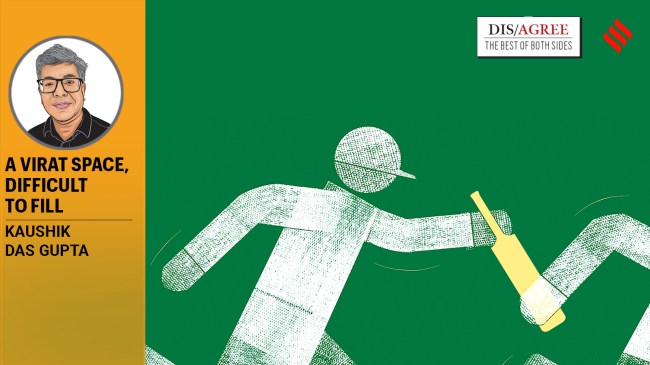Opinion After Virat Kohli, does the new crop of Indian cricketers have what it takes?
Gill, Jaiswal, and Rahul have the talent. Can they summon the tenacity and technical discipline?
 The Kohli era embodied the essence of Test cricket. (Illustration by C R Sasikumar)
The Kohli era embodied the essence of Test cricket. (Illustration by C R Sasikumar) In Virat Kohli’s first Test as captain, India chased 360-odd runs in the fourth innings at Adelaide and fell short by 48. The Indian batsmen could have pulled down the shutters on the last day and the team could have eked out a draw against the world’s top team. The target of close to four runs an over was going to be a tough ask, even though the fifth-day Adelaide pitch held no demons. But audacity was the new captain’s signature. For most of the day, in the company of Murali Vijay, he had Australia on the mat. At 240 for 2, India sensed a famous win. But after Vijay’s departure, Nathan Lyon spun a web, and by the time Kohli was the seventh out, the writing was on the wall. Nevertheless, the team had made a statement: It would not back off from a challenge. It would approach Test cricket the way it is meant to be played: Ball by ball, over by over, session by session. With Kohli hanging up his Test boots, the question that will be asked of those being heralded as his successors is this: Do they have the same tenacity?
There can be little doubt of their talent. Like the King — and the Master Blaster before him, Sachin Tendulkar — Shubman Gill gave indications of his talent in his first series in Australia. A 90-odd in the famous Gabba fortress breach of 2021 made the pandemic-hit world look up at an exciting new player. Even though he had announced his abilities with greater aplomb before, Yashasvi Jaiswal’s return Down Under earlier this year among the team’s ruins, too, led a section of the Australian media to hail him as “The New King”.
But do the new lot have the hunger to give their best in arguably the most demanding format, when the instant versions demand equal, if not more, attention? Gill has been around for more than four years, a little more than Kohli when he donned the captain’s mantle. His ODI numbers are impressive. Pedigree is also writ large on almost all his 1,800-odd test runs. Yet, an average of 35 indicates that the longest format has not seen the best of the man reckoned as the frontrunner to replace Rohit Sharma as India’s skipper and perhaps take Kohli’s place at number 4 in the batting order.
There are fears that Gill’s career arc could follow the trajectory of K L Rahul, another player with undoubted technical finesse. Every now and then, he produces an innings of great concentration — like in South Africa in 2023 and then in the early part of the Australia series. But the Rahul purple patch is yet to arrive.
Some of the current players could perhaps take a leaf out of the King’s book. Kohli is arguably the country’s greatest ODI player. He scored at more than 48 with a near-140 strike in T20Is. Yet, Kohli has always said that “the purest form of the game” received his utmost. Nothing captures his devotion better than the effort he put in after the horrors of the England tour of 2014. It was his third year in the whites and he was being seen as one of the players to watch out for. But as James Anderson and co exploited his frailties against the moving cherry, Kohli battled depression. He worked hard to make changes in technique, treating every overseas tour like an “engineering exam” he had to pass. A few months after England came the monumental effort at Adelaide.
One of the beauties of team sport is that the greats are greats because several others go about their job quietly, feeding into and thriving with the success of their comrades. Cheteshwar Pujara at the peak of Kohli’s career, for example. Pujara scored more than 7,000 runs — the value of each of them magnified by the impact it had on his teammates, while the doughty technician was absorbing all the pressure at the other end. Indian cricket today would give anything to have an enabler like him. Remember, however, that Pujara had a near-zilch presence in the instant format.
Nevertheless, as Kohli retires, there is much to look forward to. Jaiswal, for instance, willed himself to play close to his body after being dismissed for a duck in his first innings in Australia. The 170 in Perth had every Jaiswal stroke, and more. Nudged on by Rahul, Jaiswal would put his head down after every audacious shot, sometimes admonishing himself after a false one.
Test cricket demands minor but critical adjustments, almost every match, sometimes every few overs. Pitch conditions require bowlers to vary their lengths and lines. The team comprising Kohli, Pujara, Jasprit Bumrah, Mohammed Shami, Ishant Sharma, R Ashwin, and Ravindra Jadeja had players who were attentive to this imperative. Shami and Jadeja are in the twilight of their careers. Will the likes of Rahul step up? Will Gill fulfill the Brisbane promise? Where are the bowlers to fill in if Bumrah or Shami get injured? More importantly, given the pulls today, does the current lot have the drive to abide by Test cricket’s dictum of one ball at a time? The coming months will raise such questions.
kaushik.dasgupta@expressindia.com





